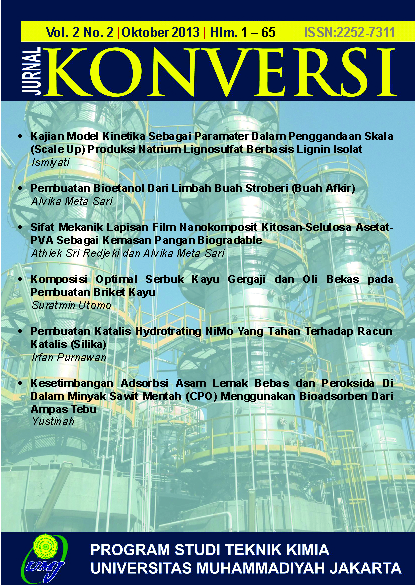PEMBUATAN BIOETANOL DARI LIMBAH BUAH STROBERI (BUAH AFKIR)
Main Article Content
Abstract
Bioetanol sebagai salah satu bahan bakar alternatif yang dapat dibuat dari bahan baku yang mengandung glukosa, pati maupun selulosa. Salah satu bahan yang bisa digunakan sebagai bahan baku pembuatan etanol adalah buah stroberi yang mudah dan cepat rusak. Tujuan dari penelitian ini adalah mencari massa ragi optimum terhadap hasil perolehan rendemen dan kualitas bioetanol, dan mencari waktu fermentasi optimum terhadap hasil perolehan rendemen dan kualitas bioetanol. Metode dalam penelitian ini yaitu dengan proses fermentasi. Buah stroberi afkir difermentasi dengan menggunakan Saccharomyces cerevisiae dan ditambah urea dan NPK dengan variabel massa ragi Saccharomyces cerevisiae (0,25; 0,50; 0,75; 1,00; 1,25 gr) dan waktu fermentasi 3, 5, 7, 9, 11 dan 13 hari. Setelah terjadi fermentasi maka etanol akan terbentuk. Campuran yang terbentuk diperas untuk diambil cairannya lalu didestilasi untuk mendapatkan etanol. Dari hasil penelitian ini diperoleh bioetanol dengan kemurnian 3,04 dengan rendemen sebesar 2,8 % pada massa ragi optimum sebanyak 0,75 gr dan rendemen sebesar 3 % pada waktu fermentasi optimum 11 hari. Dari hasil penelitian didapat persamaan sebagai berikut : y = -4,142 x2 + 7,181x-0,79 dan R2= 0,816.
Article Details
Issue
Section
Articles
Authors who publish with this journal agree to the following terms:
- Authors retain copyright and grant the journal right of first publication with the work simultaneously licensed under a Creative Commons Attribution License that allows others to share the work with an acknowledgement of the work's authorship and initial publication in this journal.
- Authors are able to enter into separate, additional contractual arrangements for the non-exclusive distribution of the journal's published version of the work (e.g., post it to an institutional repository or publish it in a book), with an acknowledgement of its initial publication in this journal.
- Authors are permitted and encouraged to post their work online (e.g., in institutional repositories or on their website) prior to and during the submission process, as it can lead to productive exchanges, as well as earlier and greater citation of published work (See The Effect of Open Access).
